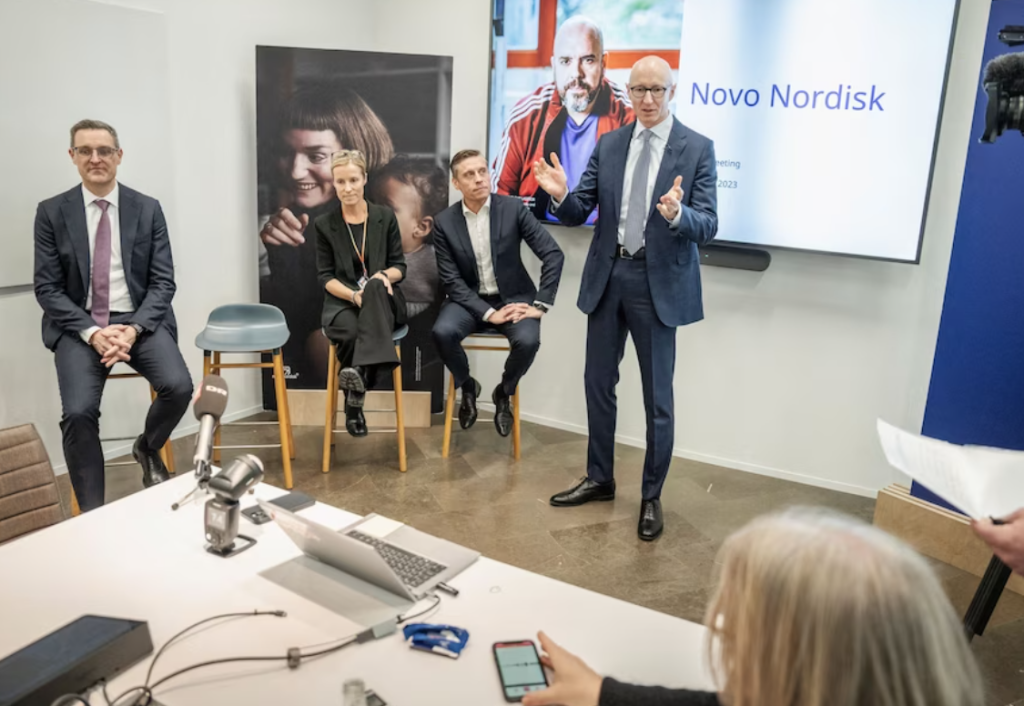Sales of diabetic and obesity treatments manufactured by Novo Nordisk, such as Ozempic and Wegovy, have been exceptionally strong, which has contributed to the Danish pharmaceutical company posting its highest annual profit in decades. This accomplishment is a direct outcome of the company’s efforts to overcome the persistent shortage of Wegovy in the United States. The announcement that Novo Nordisk made on Wednesday underlines the company’s commitment to meeting the ever-increasing demand for their cutting-edge goods. An investigation into the factors that have contributed to Novo Nordisk’s success, the challenges that the company has in the supply chain, and the overall picture of the pharmaceutical industry for GLP-1 drugs is presented in this article.
Obstacles Presented by Increasing Demand and Supply:
Ozempic and Wegovy, both of which belong to the GLP-1 class of drugs, were two of the medications that made a substantial contribution to Novo Nordisk’s remarkable financial performance in 2023. Ozempic was the most lucrative drug for Novo Nordisk in terms of revenue, producing nearly $14 billion, which is equivalent to 41% of the total sales of the firm. Another significant contributor was the medication Wegovy, used to treat obesity and ultimately brought in about $4.5 billion in revenue.
Despite its remarkable accomplishments, Novo Nordisk has struggled to keep up with the ever-increasing demand for its products. This has been a challenge for the company. In May of last year, the business restricted the starting doses for new patients to ensure that there was a consistent supply for existing patients. Semaglutide, the active ingredient in Ozempic and Wegovy, was, nevertheless, placed on the shortage list by the Food and Drug Administration of the United States due to ongoing shortages.
Doug Langa, who serves as Novo’s Executive Vice President of North American operations, said that efforts are being made to remedy the supply concerns. Novo Nordisk plans to improve the availability of lower-dose strengths of Wegovy to increase the number of patients in the United States who can begin treatment. While the corporation anticipates that supplies will gradually grow over the year 2024, there will be intermittent constraints. A market for the drug at a reduced price has been developed as a result of the Food and Drug Administration’s decision to permit certain pharmacies to manufacture their semaglutide in response to the shortage.

Those Who Are at the Head of the GLP-1 Drug Industry and Their Function:
Novo Nordisk and Eli Lilly have both ascended to the top of the GLP-1 medicine market due to their respective successes. drugs that reduce appetite operate by mimicking the effects of a hormone that the brain produces when it is full. These drugs are known as appetite suppressants. It is anticipated by analysts that GLP-1 treatments, which are delivered through injections once a week, will eventually become the most prevalent category of drugs utilized all over the world.
It is a tendency that pharmaceutical companies are always looking for new ways to make their goods more convenient for clients, and this trend can be observed in the heated competition to manufacture tablet forms of these treatments. Novo Nordisk is in an excellent position to capitalize on this shifting environment as a result of its dominant position in the GLP-1 market. Eli Lilly, on the other hand, is a formidable counterpart. The astonishing success of GLP-1 drugs has brought to light the huge influence that these treatments have had in the fight against the epidemics of diabetes and obesity.
Important Financial Indicators and Trends in the Market:
Remarkably, Novo Nordisk’s annual net profit in 2023 was 83.7 billion Danish kroner, which represents a 51% increase from the previous year’s figure. According to S&P Global Market Intelligence, this is the most substantial annual profit that the corporation has made since 1989 when converted to almost $12 billion at the current exchange rates. Both the success of Novo Nordisk’s medications and the growing need for innovative approaches to treating diabetes and obesity are reflected in this financial achievement, which is a testament to both of these factors.
The constantly shifting environment of the pharmaceutical industry, particularly about GLP-1 drugs, is illustrative of the sector’s capacity to adjust to emerging health issues. There was a significant increase in the number of alternative, pharmacy-made versions of semaglutide after the Food and Drug Administration (FDA) declared a shortage in March of 2022. This was evidence of the market’s resiliency in the face of supply limitations.
Post Source: washingtonpost.com

























